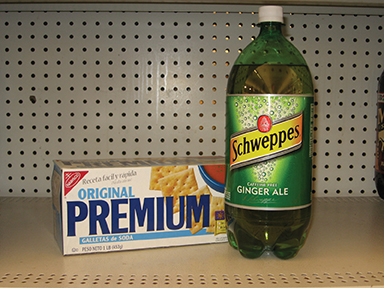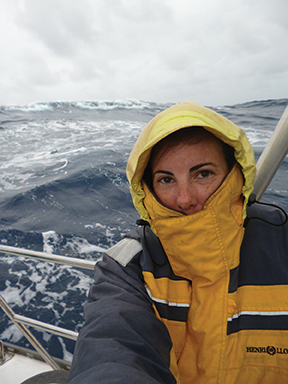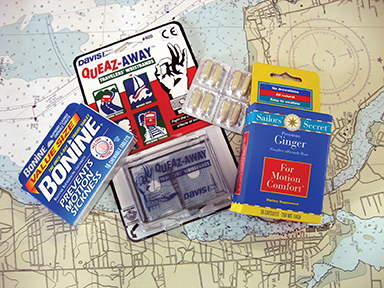Seasickness can affect anyone and range from an annoyance to debilitating, however there is relief. (published October 2015)
On a recent passage from New Caledonia to Vanuatu I battled against the age old affliction of seasickness. It had been awhile but I was expecting to feel unwell on this particular trip. We were sailing on a deadline and couldn’t wait for the perfect weather window, a 20 knot head wind and two meter seas were the best we could get. Kate performed well, but the jagged rocking-horse motion of the boat as she fell off waves and plowed into the swell is one my body cannot reconcile with. I prepared for the worst and hoped for the best. The acutest symptoms, the sudden fits of vomiting, lasted only for one afternoon, but it took two days before I started to feel normal again.
During the trip I wondered how many other people suffer from seasickness. Cruisers are always keen to swap sailing stories but not many people talk about how they deal with this potentially debilitating condition. Like anything, the more information you have at hand the better prepared you will be to deal with the situation.
ONBOARD MOTION DETECTORS
Seasickness can affect anyone—old salts, first time sailors, men, women and, contrary to popular belief, children under two. It is not a sign of weakness or inexperience, it is just a simple case of mixed messages.
How our bodies understand the sensation of being in motion is interpreted by the inner ear, but our eyes also observe motion by relaying where we are in relation to our surroundings. There are also pressure receptors in our skin, muscles, joints and spine that gather information about which part of our body is moving. When info from these sensory organs conflict, sending mixed messages to our central nervous system, our brains get confused and the result is that we feel seasick.
Usually the first symptom is a feeling of drowsiness or general malaise. If you’re lucky this is all you experience. For the rest of us there will be hot flashes, cold sweats and possibly dizziness. Usually people feeling seasick will look pale and it is often commented they appear “green around the gills.” Some people experience headaches and many suffer nausea and vomiting, sometimes violently. For some being seasick is simply an annoyance, for others it can be debilitating. If not treated properly seasickness can quickly lead to dehydration, which can be fatal.
KNOW YOUR TRIGGERS
Everyone experiences seasickness in different ways, and what triggers that feeling can vary between people as well. Classic triggers include: concentrating on an activity below decks like doing dishes or plotting on a chart, strong fuel smells, getting overheated, odors from the head, drinking alcohol, eating particularly spicy or greasy foods and reading.
Some people suffer seasickness after being stationary for a period of time, this includes not only time on land but being anchored somewhere calm and protected for awhile. The first time back at sea you might feel like you “lost your sea legs.” If possible break the trip into short hops or do some day sailing to get reacquainted with the motion of the boat again.
If you are a cruising sailor, setting off on long passages often involves bidding goodbye to friends, either ashore or on other boats. Usually this is done last minute, after all the preparations for the trip are finalized, and often involves a few drinks. But fun at anchor can come back to haunt you when at sea. Instead of making the goodbyes last minute events try to plan something in advance; this will allow everyone to celebrate and more importantly, recover.
A good method to recognize what your triggers are is to keep a record of how you feel before and during passages. Trying to write things down while underway might be difficult if you are seasick so consider using a voice recording app on a phone or MP3 player instead. By making notes about what you ate, sea conditions, medication used and your general health you will be able to see patterns and identify triggers, which will better help you cope when you do fall sick.
CURING WHAT AILS YOU
I am not sure you can ever really “cure” seasickness, however, it is agreed that over time your body can adapt and adjust to the irregular motion of the boat. Most people find that after a few days underway symptoms of seasickness dissipate and they are able to resume normal activities. If spending a couple days functioning in what I lovingly refer to as “survival mode” isn’t what you consider fun there are several remedies to control or prevent seasickness.
In general, over-the-counter medications for motion or seasickness, such as Bonine, Dramamine and Scopolomine, have the side effect of making the sufferer drowsy. This condition can range from heavy eyelids to coma-like induced sleep. Discovering that the chosen medication knocks you unconscious for several hours is not really something you want to find out far from land on a long passage. And keep in mind that what works for your spouse, child or friend may not work for you. To be safe try new medications and remedies on shorter coastal passages, if there are any bad side effects you will have a chance to try something else or at least know what is in store for the next time you are at sea. One over-the-counter medication called Stugeron has a loyal following among cruisers and it works well without the drowsy side effects. It is available worldwide but not in the U.S.
There are a variety of homeopathic remedies for seasickness including ginger tablets, acupressure wristbands and aromatherapy products designed to be worn on pulse points or inhaled when needed. Some people argue that these are simply placebo remedies but I tend to think there is a lot in nature we don’t yet understand. If you don’t like the side effects pharmaceuticals these are a good alternative.
COPING MECHANISM
Widely given advice about seasickness is to take the sufferer up on deck, have them steer the boat or at least watch the horizon. For most people this simple trick will ease a lot of the symptoms. However if you are motoring make sure the wind is not blowing exhaust fumes onto the sufferer stealing their fresh air and potentially making them feel worse.
Frequently other crew members are required to sit more watches, do more work and get less sleep to make up for a person who is ill. This can be exhausting and compromise the safety of the vessel. I often feel better during night watches, not only is it cooler but the darkness obscures a lot of visual information so my brain is less confused. If you also function better at night it might be a good idea to arrange the watch schedule so you sit more night watches, giving other crew members a much needed rest. Taking on extra crew for passages is another option; just make sure they know if they are affected by seasickness as well, not very useful if the help ends up sick too.

For passages I always have the first few meals premade and ready to reheat, eliminating time that anyone has to stand watching a hot stove swinging around. It is best to avoid eating anything particularly acidic, so stay away from citrus, pineapple, tomatoes and vinegar based salad dressings. Strong tea and coffee can be acidic too so opt for a weaker version for the first few days or if you are looking for something to warm you up try herbal teas, flavors such as mint and ginger are known to soothe upset stomachs. Spicy foods can be hard to digest, as can oily or fatty foods, it is best to avoid these if you’re in doubt. And cookies and chocolates can quickly go from a sugary treat to sickly sweet, so unless you want to literally ‘woof your cookies’ it is best to limit desserts.
If you are prone to seasickness think about adopting your “at sea” routine for a few days before departure. Limiting or avoiding trigger foods, alcohol and caffeine, and making sure you are well rested before you set sail can give you a head start in the race against seasickness.
WHAT WORKS FOR YOU
Over the years I have built my own routine for coping when seasickness strikes. After we have the boat on course and sailing fine my partner takes the first watch and I go below to try to get some sleep. By eliminating the visual clues of movement and letting my body relax while adjusting to the motion of the boat I find I can adapt much quicker, often avoiding the worse symptoms of seasickness.
My routine is contrary to almost all the advice I had read about seasickness but it works for me. Everyone experiences seasickness differently, from triggers to symptoms and reactions to remedies and medications. So, listen to your body and figure out what strategies work best for you.
And don’t forget your mental game. Seasickness is caused by a confusion of physical sensations within the body but if you are nervous or scared about being at sea it can make it worse. There is a fine line between being prepared for a time when you might feel ill and convincing yourself that you will be seasick. Try to stay calm and positive. Remember feeling seasick will pass, eventually.

Heather Francis is from Nova Scotia, Canada and has worked and lived on boats throughout the world. In 2008 she and her partner Steve bought Kate, a Newport 41′, and have been sailing ever since. They are planning to do a lap around the planet, albeit slowly. To follow their adventures log onto www.yachtkate.com.
SEASICK SMALLS
It is often said that children under 2 years old don’t succumb to seasickness but this isn’t true. I spoke to friends on two boats that had toddlers that suffered regularly with seasickness.
The biggest concern with seasick children is dehydration, which can be compounded by heat when sailing in the tropics. One mother reported making sure her child had a sip of water every five minutes until he was able to keep a whole cup of liquid down. You can also try diluted fruit juices or electrolyte replacement drinks formulated for children.
Both boats said that keeping the kids up in the cockpit, including making a safe bed for them to nap there, made them feel better. Of course kids in cockpits, especially underway, means lifeline netting, lifejackets and tethers to keep them safe. And both parents agreed that the kids eventually recognise what activities and remedies give them relief and after a few days at sea adapted well.
If you are going to give a child any medication it is important to consult a pediatrician first. They will tell you what medications works best for children, proper dosages for varying ages and how to recognise potential side effects and danger signs.
DEHYDRATION
Dehydration can be fatal so it is important to keep your fluids up, especially if you are vomiting. Taking small sips of water every 10 to 15 minutes is much more efficient than gulping a whole glass. If it is cold on watch try sipping hot water or a weak broth. You can monitor your hydration levels by the color and frequency of your urine; dark, concentrated pee and infrequent bathroom trips are a sign of dehydration.
Don’t just drink, eat. This sounds counter intuitive if you’re vomiting but it makes the difference between horrible dry heaves and actually having something to throw up. Have a supply of ready-to-eat, easy-on-the-stomach snacks handy; carrots and celery sticks, saltine crackers, ginger snaps, peanuts butter crackers, rice or other easy to digest, bland foods. Eat small portions and eat often.















